| |
 |
            |
 |
Week 41
|
|
| There was a surprising start to Monday morning – about a foot of snow. We stood looking out of the window, unable to understand what had happened; we were dumbstruck, having arrived in quite nice weather.
As we hope to visit the Ukraine in a few weeks time, we had to apply for a visa, which was only obtainable from a Ukrainian Consulate, so we thought that Belgrade would be the easiest place to make an application.
We took a taxi to the Consulate and were told that we had to wait outside, we thought for thirty minutes, but in fact it wasn’t more than ten. In the meantime, we were able to watch the snow from the pavement being shovelled into the road, so that the cars and lorries drove over it, reducing it to water which drained away!
The good news from the Consulate was that rules had come into force, so we didn’t need a visa for a visit of less than 90 days.
Gary somehow managed to commandeer a taxi and we went to have a look at Belgrade. The weather didn’t help, but it is a rather grey, austere city with a heavy Soviet style. We were told that the best place for lunch was in Skadarska, apparently hailed as Belgrade’s answer to Montmartre. It was quaint and utterly unlike the rest of the city and lunch was very good.
If the weather had been a bit better, we would probably have seen more of the city, but the conditions were pretty dreadful. If that wasn’t enough, it was discovered that Josh’s shoes leaked, so we spent a couple of hours trying to get him a new pair of trainers. As the city is quite poor, I was expecting trainers to be priced accordingly, but no; most of ones we saw (and we did go to an awful lot of shops) were around £80 and the cheapest ones were £50. Given that, as a rule, as soon as we buy a new pair of shoes for Josh his feet grow another couple of inches, I’m afraid that instead of buying the exorbitantly priced trainers, we got a taxi back to the hotel, where we could dry off the old ones. Well, it won’t snow for ever will it!!
The following day we went further north into Hungary. It was a pleasure to be back. It is a very civilised, normal feeling country and although the language is entirely alien, the people are not. We went to Kiskunmajsa, a spa town with a campsite that was open – perfect.
The thermal baths were just a couple of minutes walk from the campsite. Gary had a cold and Josh decided to stay with him to keep him company, while Rory and I tried out the facilities.
The first surprise was the colour of the water. In the smaller hot pools, it was just a sludgy colour, but in the main swimming pool it was a very dark green. It was about 5 feet deep and if the water was still, you could just make out the bottom; otherwise, it was impossible to see below your waist. It was very odd.
Unfortunately, when Rory lost his metal tag (exchanged for his clothes), the difficulty in seeing the bottom became rather crucial! I walked up and down the length of the pool trying to find the wretched thing, ran my foot all over the filter, all to no avail.
The attendant was entirely disinterested when I tried to explain what had happened; she just shrugged her shoulders and got back to her conversation with her friend. Not her problem. I had to interrupt to regain her attention, to try and find out what we should do. Eventually, she pointed in the general direction of the cash desk. So off we went there. No luck, the cashier didn’t speak any English or German and had no idea why I was there. So back we went to the attendant, who shrugged some more. We went back to the cash desk and luckily there was someone else on duty and we explained our plight again. She took went to the manager of the complex to explain what had happened, then we had to wait til a pool attendant came, who spoke English. He said we had to have the token and suggested we look for it……. My patience was wearing a little thin by his point, as we went over the whole story again. After much discussion, I was told that we would have to pay 2000 forints (about £5), for a new token, then Rory could have his clothes back. I knew I had a small amount of money on me, counted it out and found that I was 15 forints short. It defies conversion to say just how little this is, but they were unrelenting. Thankfully, as I turned out all my pockets, I found another 100 forints, so was quids in and Rory could finally get dressed. What a performance, I can’t believe that no-one else has ever lost a token there, but can well believe that no-one would do it twice!
The campsite and baths were on a main road, so we were quite surprised, to say the least, when a train ambled along a track in front of us!
On Sunday, we drove up to Budapest and met up with Janos, Eszter and Julia. It was lovely to see them all again. We had the most enormous pizzas ever for supper; the boys couldn’t believe their luck. The next morning, breakfast was an even bigger feast, Rory ate more than he had at any other meal in his life, I think. A continental breakfast obviously suits him.
|
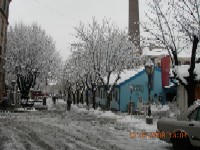
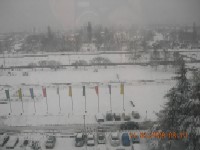
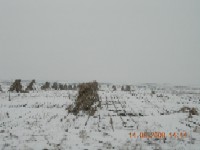
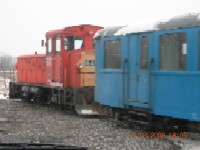
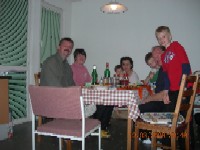
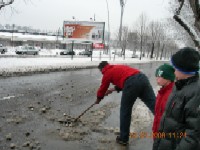
|

Week 42 |
|
| I was a little apprehensive as we drove into Rumania; let’s just say that I had heard differing stories about the place. I soon found that is an absolutely fantastic country and one that I certainly hope to go back to and spend more time there.
There is so much to see and the people are so helpful and friendly, I would gladly spend three months just looking around and even then would probably only see a fraction of the beautiful towns and countryside.
At first we found the money very confusing. At one level it is very simple; there are 5 lei to £1 – what could be easier….. Well, there were 50,000 old lei to £1, so the government devalued the currency and knocked off four noughts. The old currency is still in circulation, so in your pocket you will have a confusing mixture of old and new lei. If goods are priced, then it will be in new lei (mostly), but if not, then the seller will tell you the price in old lei – but will knock off three noughts, as these are always implied, but not stated. So if someone says that the price is “500” you first have to work out whether that is 500 new lei (£100) or 500 old lei, ie 500,000 old lei, (£10). When the item is a hand-knitted pure wool jumper, it seems too expensive at £100, but too cheap at £10. in fact, it was £10 – 500, 000 old lei. So you can hand over 60 new lei and receive change of 5 new lei and 50,000 old lei and that would be correct.
Frankly, we never knew where we were with it all!
But, the great thing was that the Rumanians never cheated us, even though we were like lambs to slaughter. After a day or two, when we realised that we never would be able to understand it all, we would just hold out a wad of notes, they would take what they wanted and, if appropriate, handed us back some change. It worked perfectly, and we honestly never had a moment’s concern. There are not many countries where you could do that.
The first town we stopped at was Cluj Napoca. It is a very pretty university town, with many painted baroque buildings, which has a good feel about it. We felt perfectly happy exploring the narrow streets and alleys. In the main square there is a vast church – St Michael’s and outside a huge statue of the famous medieval Hungarian king Matthias Corvinus.
Magnificent buildings abound here, like the twin buildings I have shown here, flanking a street off the main square.
The National History Museum of Transylvania had a good write up in Lonely Planet, so we decided to visit it.
They are carrying out a re- design of the whole museum bit by bit, so while we were there we were not able to see the medieval section, which was a shame because the boys are now very interested in medieval weapons.
However, this was more than compensated for by the superb tour we were given of the prehistoric section. The 300 (old!) lei entry ticket (60p) (no, I couldn’t work it out either!!) covered a personal guide who, not only spoke English, but also was a highly qualified historian, who really did know all about the exhibits and explained them in a way that brought them to life. For example, I had had no idea that a race of people, called the Dacians. had lived in Transylvania for hundreds of years, but then died out. They had no written language and built with wood so very little is known about them, except that they existed.
The highlight of the visit for the boys was the incredible Egyptian section, with a real mummy, which had been X rayed, so you could see the skeleton that was beneath the bindings.
Our guide was Ioana Savu, and she transformed our visit from what would probably have been a brief, and incomprehensible look at unknown objects, described in an unknown language, into one of the most interesting museum visits we have had. Because she was interested in what she was describing, it became interesting to us. Also, she gave short, precise explanations that we could understand and did not launch into all she knew about each subject. She seemed to work on the basis that she would give the main facts and if we wanted to know more, we only had to ask, and we frequently did.
Other museums could learn an awful lot from the ways things are done at the museum in Cluj.
From Cluj, we made our way to Sibui, which is one of the most stunning towns I have seen. Words cannot possibly do it justice and you will just have to go there to see it for yourself. It will be European City of Culture in 2007 and certainly deserves the title. It is not the easiest places to get to, but it is well worth the effort and once there, you won’t want to leave
We took a trip to the top of the Council Tower – breathtaking – both the view and steps to the top! The photo of the church spire was taken from there.
Josh and I looked in at the Evangelical Church. I was thinking we would have a quick scoot round and be out in ten minutes. There was no entrance fee, but the man in the postcard kiosk asked if I would like to have a guided tour of the church. Well, I didn’t like to say no, so agreed. Stunning is the only way to describe it (I must get a thesaurus for synonyms of stunning). The interior was largely plain, but the remaining pictures told a thousand stories. The church had been catholic, but the coming of Lutheran ways meant that the pictures of saints were painted out. One remaining picture of the crucifixion shows Christ on the cross, but at the bottom of the cross you can see disembodied hands – those of the saints gathered round. There bodies were painted out, but because they didn’t want to paint out the cross, they had to leave the hands in. If you look in a certain light, you can see the outline of the halos.
Another painting shows the crucifixion, but with images of both heaven and hell, apparently there are only two like this in the world.
The third painting is of the Last Supper and the then Mayor, got himself and one of the aldermen painted into the picture. Crassness knew no bounds, even then!
In the crypt are many old tomb and tombstones; among them is Vlad the Impaler’s son. Josh was more fascinated with the tombstone showing the smiling skull and crossbones with an inscription along the lines of “Me today, You tomorrow”!!
|
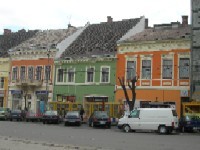
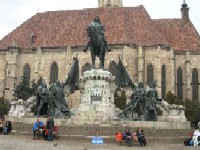


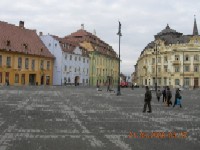
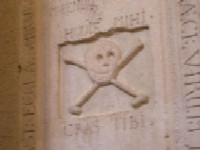

|

Week 43 |
|
| We could hardly be in Transylvania and not go to Bran, home of Dracula’s castle, could we?
We did the obligatory tour and bought false vampire teeth, battery operated ghouls that laugh maniacally at the clap of a hand and generally had fun.
We were so lucky that there was also a campsite in the village itself so we could walk to the castle. Vampire Camping is all a campsite should be and I am sure that it will be a great success. The facilities are new and work, but the best thing about it, is the attitude of the manager. When we arrived, the campsite was not really open and the facilities would not be operational for a couple of days, but instead of turning us away and getting on with the work in hand, he asked what we really needed – a secure space- and since he could provide that, let us stay at a very reduced rate. A Godsend!
We were directed to the Wolf supermarket that was a ten minute walk away, bought some groceries and settled down for the night.
We were woken at about one in the morning, by a little, frightened voice, “Mum, can I have some garlic!” All the fun of the day isn’t quite so funny at night, when you are absolutely sure that you heard a werewolf and then felt him shaking the motorhome. I got out of bed, rummaged in the fridge, and produced the life saving bulb of garlic!
At the supermarket, I had bought a string of garlic for 50p – a real bargain. The boys thought that I had bought so much for protective reasons!!
It was very cold on the first day in Bran and we were very glad that the small restaurant we ate at had one of the marvellous stoves in the room. As you can see from the photos, it is about five feet tall and four feet across and the whole thing heats up like a giant radiator and gives off masses of heat. We have only seen them in Rumania, but they are great.
The village of Bran is of course entirely given over to Dracula mythology, but the local graveyard is truly creepy. I couldn’t believe my eyes when I saw that some of the gravestones were seemingly complete, except for one small thing – the body. The person’s name and date of birth is given and a space is left for the date of death. I don’t know how anyone can look at their own grave. The morbid space just waiting to be filled would give me the heegy beegies. Still, it would be no good if we were all the same, would it?
Crossing the Carpathians was a lot easier than we expected and we had no problems with the road. The Rumanians certainly know how to do hairpin bends. They are very wide, so you have plenty of space (and no fear of inadvertently dropping over the edge) but the road is heavily cambered, so you feel that you are being pulled safely round by the road itself. The Italians should take note!
We were going to the Southern Bucovina region of Rumania, which is famous for its painted monasteries. On the way, we saw our first stork’s nest with the bird actually sitting on the nest. A magnificent sight.
The frescoes on the monasteries are also magnificent. We went to three of them and my favourite was the Voronet Monastery and the colour used is known as Voronet blue. We were again given a guided tour of the interior, this time by a young nun. It is so nice when people are clearly interested that you enjoy the visit and are so willing to give their time to make it as enjoyable as possible.
Another striking feature of Rumania is the use of flamboyant colours on the houses. We saw many that were intensely purple, intensely red or intensely green. The one in the photo is more muted, being just a garish yellow, but they all made the towns seem very cheerful.
From Rumania, we crossed into the Ukraine. But, before we could actually get there, there was the small matter of the non-payment of the vignette for using Rumanian roads. We breezed up to Rumanian passport control with not a care in the world. The official seemed nearly as aghast as we were that we didn’t have the wretched yellow paper and kept suggesting that we might have mislaid it in the motorhome, but we knew we had never heard of it and certainly had not bought one. What was worse was that the fine was 1,200,000 lei (old ones thankfully!), but we didn’t have enough lei left and nor did we have euros. They just laughed when we asked if we could pay by credit card!
There didn’t seem to be anyway around it and we didn’t know what to do and nor did they. The finance man couldn’t let us go without paying and we couldn’t pay.
Eventually, one of the border guards drove me back through the border and into the nearest town so that I could change up sterling into lei for the fine. The fine was £60 and the cost of the vignette also had to be paid – 40p!
The border guards were also utterly mystified as to why we should be going to the Ukraine. Why did we want to go there? There was nothing there. We must be very careful on the roads and never drive at night. The unsolicited advice was beginning to make me think about turning back, (not that we could of course as we were impounded at the border!)
Getting into the Ukraine couldn’t have been more straightforward. The guard looked at us, asked if we had anything to declare – no – were we sure we had no narcotics or Kalashnikovs – we assumed he was joking and we were through.
The first thing we did was to buy a really good map and we were off. The roads were not too bad to begin with, but after a few miles deteriorated into what became the Ukrainian norm of immense potholes and the worst roads we have experienced. In fast, in some place the potholes were so numerous, you couldn’t really call the remaining pieces of tarmac a road at all.
The poor motorhome banged and shook its way down the road, but took it all in its stride!
Because the roads are so poor, we couldn’t travel very far each day. We thought that finding somewhere to stay might be a problem, but there were plenty of truckstops and for a small sum, we were welcome to park there.
An unexpected bonus, was the quality of the food. It was really delicious. We didn’t always know what it was, but it always looked good and tasted better. Understanding the menu was an even greater challenge than usual, so the meals could have been terrible, but I don’t think we had a bad meal there, at all.
We arrived in Kiev on a Sunday afternoon, expecting to stay at an international hotel, for hopefully a reasonable price, as we had done in Belgrade. There were no international hotels, in fact, as far as we could see, there were no hotels at all. This was a bit of a low moment, as we had not anticipated that a capital city might not have any hotels. We drove round and round and up and down, but with no luck, although we were getting quite a good idea of the layout of the city!
When the policeman pulled us in, the low moment sank further. He blew his whistle and waved his stick and there was no doubt it was us he wanted to see, so we pulled in to talk to him. Given the quality of his English and our Russian, we think, but are not sure, that we were over the weight limit for the road. We had to produce every bit of paper we had and they were all duly scrutinised. Then, he asked where we were going – well, we didn’t know, did we?! So we “asked” him if he knew of any hotels (anything to take his mind off the weight of the vehicle!). He was being very officious, but went to his car and got a map. We had a better one, so invited him into the motorhome to look at ours. As soon as he saw the children, his attitude utterly transformed and he became the most helpful person on the planet. There were only two – one was a five star hotel and very expensive with underground parking (we don’t do underground – the chances are not great that we would come out in one piece) and the Drushba which he recommended. To get there we would have to continue along the road – still overweight – but this was now no problem.
The hotel was very Soviet, but was just what we needed. Payment was in advance and the key was collected from the housekeeper who had a desk in the corridor on our floor. There was a full sized domestic fridge and domestic kettle, a small table and chairs and a TV in each of the adjoining (enormous) rooms. The boys bed was a put u up, and the housekeeper brought in bedding, but it was our job to put the thing up and make the bed. This, the luxury suite, was £70 a night.
Parking was extra and we had to see a separate man about that, but it all worked out in the end.
Kiev is a strange city, but the magnificent, massive 62m titanium sculpture known as Rodina Mat or the Defence of the Motherland Monument makes up for any shortcomings, real or imaginary that the city might have. This awesome work is worth making a trip to Kiev for, even if you just arrive, go and see the sculpture and take the next plane home. It is that good.
We went to the Caves Monastery, where we thought we were going to see naturally mummified bodies of monks who lived and were buried in the caves. All you can actually see is a bundle of clothes with a black satin square over the bindings, where the face might have been. The place is treated with enormous reverence and many people were staring at the bodies and kissing the glass cases, but as we have not been brought up with the tradition, we were left unconvinced. The fact that I was the only person there who they made put on a blue store man’s type coat over my clothes, so that I looked a complete idiot, has nothing to do with it. I never will know why, I wasn’t the only foreigner and I was covered from head to foot in my own clothes, including a headscarf I had bought at the gate. The boys thought is hilarious, luckily, no photography was allowed.
We didn’t see much of the rest of Kiev, as it is not user friendly at all. We didn’t even manage to find the Chernobyl Museum, which was the reason for going there. It is hard to explain, just how difficult it is to get around. No-one seems to know where anything is, very odd.
The last two pictures are of the main square and St Michael’s Monastery at the top of the souvenir touting cobbled street, Andriyivsky Uzviz.
|
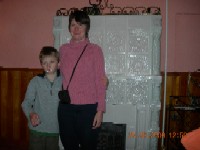
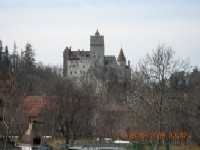
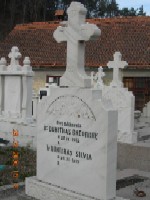
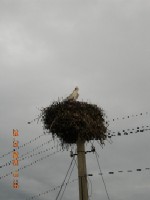

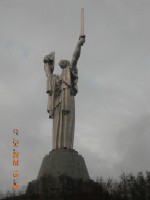

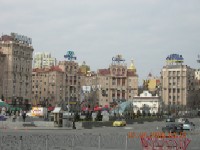
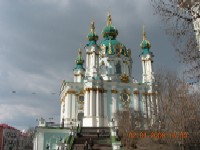
|

Week 44 |
|
| Driving out of Kiev, we saw mile upon mile of depressing looking Soviet block housing. Many of the blocks looked to be in a very poor state of repair, some with enormous cracks running through them and roofs that were parting company. The scale of it makes it hard to imagine how the problem could be addressed. How could so many people be re-housed whilst the blocks were structurally repaired or pulled down and re-built?
Along the road, we saw some strange leaves being sold, so just had to stop to have a closer look at them. They were large bunches of dried leaves, but what were they for? The lady selling them spoke English like I speak Ukrainian, and we soon established that we had no languages in common at all. So by sign language, I asked if they were for sweeping up – a mystified shake of the head was the reply. For eating, I gesticulated? She laughed. So, then it was her turn. She took the bunch and started hitting herself with it – I thought that maybe we had stopped at entirely the wrong sort of stall! But then she said the word “sauna” and all became clear. We bought one, just to thank her for the entertainment we’d had. She was also selling some health giving drink distilled from the silver birch tree, which she managed to convey was excellent for the children’s wellbeing.
The picture of the aeroplane and man on horseback are just examples of the extraordinary sculptures that suddenly appear out of nowhere. They are magnificent pieces of art work that are scarily realistic – another reason not to drive at night, they would be terrifyingly real in the half light!
The journey from Kiev to Lviv was too long to do in one go and so we spent another night in a truckstop. This one was in the middle of nowhere, but it had a super restaurant and the owner had the foresight to have an English menu, so we actually knew what we were eating, which made a nice change.
It wasn’t easy to find places to stop, as most of the villages we passed through, were just a collection of very poor houses, with no amenities at all. In many, if not most, villages, there was no running water, and it was a regular sight to see people walking back from the village well carrying a bucket or two of water. All very well, unless you are elderly, infirm or disabled, or the weather is bad.
We take running water for granted and waste large amounts of it without giving it too much thought. Certainly, getting all the water from a well would put an end to the wastefulness. Also, there would be no washing machines or dishwashers to guzzle up gallons every day.
We are not sure if the houses had electricity. We couldn’t see any overhead cables, but it could have been brought in underground. As we didn’t travel in the dark, it wasn’t possible to be sure, though, personally, I doubt it.
The people seemed to practise subsistence farming on small plots of land. It was a very common sight to see whole families working around the house and garden. We saw Many elderly women, working on their own, laboriously digging over patches of ground ready for planting. It seemed quite clear, that unless they did the digging, there would be no food later in the year. Not an inch of the garden was left uncultivated. There were no lawns or flowerbeds, just dug over earth. The Ukrainians living in the country have the hardest lifestyle that we have seen.
A bizarre, and rather disconcerting, feature of the Ukrainian roads was the staggering number of roadside memorials. There was literally one (or two or three) every 100 -500 metres; as we passed one, we could already see the next one. This went on for hundreds of kilometres. In the end it made me feel spooked, Gary didn’t admit it, but I think it got to him too, he kept commenting on them, every minute, for hours!
We arrived at Lviv, thinking that we would find a hotel similar to the one we stayed at in Kiev, but it soon became apparent that we were not the type of customers they were looking for. We were not business people with large expense accounts. The only place that was suitable, wanted 180 euros a night for a double room, but we would have to have two rooms. Then, as if 360 euros a night was not enough, there was a daily parking charge of 15 euros on top. As we wanted to stay a few nights, we would have been penniless.
So we went back to the idea of a truckstop, and found a perfectly nice one just on the edge of town for 2 euros.
In the morning, we drove in and parked right in the centre of town and began our sightseeing. Lviv is a small, accessible town with superb architecture.
The main square is a spectacular array of buildings dating from the 16th century. At the time we were there, further excavations were being carried out and the whole square being re-laid with decorative stones. When the work is complete, is will be an absolute delight.
The Theatre of Opera and Ballet, which is the photograph with the three figures on top, is magnificent and is situated on a pedestrian boulevard in the centre of town.
We went to a very unusual department store. The lighting of the galleried three storey building depended upon an atrium, which I have to say made for a rather gloomy interior. Rather than open departments which would be usual in England, each department was a table or stall, all joined together, so you could just walk around easily and see all the wares. I even managed to buy a couple of pairs of socks for the boys, this was something of an achievement, as the measurements were in centimetres rather than shoe sizes – much more sensible, but confusing if you are not used to it. The lady soon got me sorted out, and we were both pleased that the transaction ended successfully!
We had a marvellous lunch in what seemed to be a posh restaurant, in the main square. It was very reasonable, about £5 a head for two courses and drinks starched linen tablecloths and silverware provided at no extra cost!
We spent another happy night at “our” truckstop planning the next bit of the trip with the aid of Lonely Planet, when Gary read that when you enter the Ukraine you have to declare all foreign currency and get a form showing the amount declared. When you leave, the only currency you are allowed to take out is that shown on the form. The only small problem was that as we hadn’t read the book, we hadn’t declared the money; the penalty was confiscation of the undeclared funds, some £3800 – ouch. We decided to hide it in an old tin in the food cupboard. I was very nervous going through the border, but luckily, the border people were charming, they only wanted to come and have a look round then waved us on, phew!
The border crossing took quite a while, six hours to be precise and that was with the aid of a 30 euro “facilitation fee” (paid in cash and without question to a man who approached us when we were in a queue that hadn’t moved in three and a half hours, half a mile from the border), without which we might still be there!
I don’t know why, but I always imagined Warsaw to be a dark, sinister place; I could hardly have been more wrong. The old town is delightful. The last two photos were taken in the Old Town and show the huge effort that was put in to almost entirely rebuild it after the devastation of the war.
We went to the museum and saw poignant film about the bombing and it is a wonder how the people managed to regenerate the city from the rubble.
The Marie Curie Museum is also in Warsaw, as she was born there. It was very interesting, though I have to admit that the science was rather over my head.
If you are in Warsaw, we can thoroughly recommend the Gospoda Pod Kogutem restaurant, not far from the Marie Curie Museum, the food is wonderful, especially the puddings, which we treated ourselves to. We had hoped to eat there the following day, but it wasn’t to be.
|
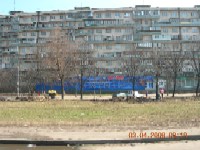
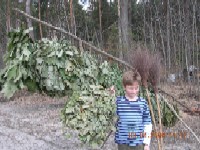
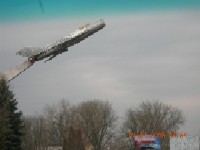
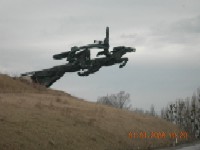
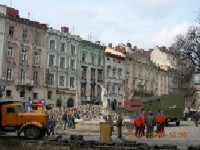
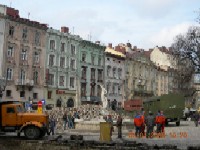
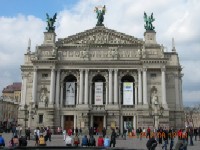
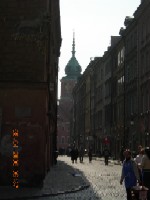
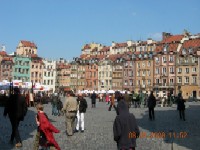
|

Week 45 |
|
| After a long day in Warsaw, we came back to the motorhome and decided to watch a DVD. The family choice was Oliver Twist and I have to say I found it rather long and I had a stomach ache that didn’t increase my enjoyment at all.
At last it ended, but the pain was still there. Gary had to help me to the shower block as I couldn’t walk on my own, at the time, this didn’t strike me as odd. The pain got worse and he wanted to call the doctor. I was lying in bed, unable to move feeling very sick, but adamant that I was perfectly all right and that the pain would be gone in the morning and that he should stop making a fuss and scaring the children. (You get the picture, I am sure).
By 11.30pm Gary decided to call the doctor whether I wanted one or not. Because of our lack of Polish, giving the directions to the campsite wasn’t easy and I have to say that the campsite owners were not overly helpful.
Anyway, the doctor and ambulance arrived just after midnight. How ridiculous, I thought, for a stomach ache! I couldn’t believe it when she wanted me to go to the hospital straightaway, as she suspected appendicitis.
could believe it even less, when, at 4 o’clock in the morning, I was on the operating table and a soothing man was asking me if I was feeling sleepy, I was asleep before I could reply.
Gary and the boys were allowed into the recovery unit to see me; they said that it was state of the art, with a full resuscitation unit for each bed. Luckily, I didn’t need it and was soon wheeled back to the ward.
There were four of us to a ward with our own loo and hand basin. Unsurprisingly, the other women spoke Polish and so once we had said hello and they realised that I was English, conversation was rather limited. Not that I particularly noticed, the drugs saw to that.
The hospital was about a mile from the campsite, Gary, Josh and Rory came to visit three times a day, so they were doing a route march of six miles a day. On top of that was the half mile walk in the opposite direction for KFC – a previously unknown pleasure! I think that they sometimes got a taxi back, to prevent total exhaustion setting in.
The hospital was very like an NHS hospital, excellent medical care, but no frills.
There was a rigid routine for the mornings. At quarter to six we were awoken by injections, and plenty of them, the timetable was so precise that if you weren’t actually awake, you were given the injections anyway!
Breakfast was at 7am. For the first two days, I wasn’t allowed to eat, so as you can imagine, by day three I was really looking forward to my “special food”. At first I thought it was chicken soup, as it was served in a soup bowl and was a creamy colour, but no, there was no taste to it at all. Even the consultant said that it tasted terrible, and he was right. I can’t imagine that it really was hot wallpaper paste….. maybe it was a solidified residue from boiling rice for far too long in unsalted water…. who knows. I managed to swallow it the first time it appeared; at lunchtime, I managed half, but brought it all back up again. At teatime, I just left it where it was. A pity really as it was all there was on offer, for poor post operatives like myself. The other women had things like roast chicken and stew, it smelt torturously delicious. No doubt it was a marvellous cure-all, but only if you are Polish!
The consultant’s round was at seven thirty, and the entourage swept importantly into the room with a flourish, like consultants the world over. The great man pushed and prodded to my agonised groans, pronounced that it didn’t hurt and moved on. Didn’t hurt who? I wondered. No doubt he didn’t feel a thing.
I was discharged on Wednesday, feeling rather shell-shocked by the whole experience.
By Friday, I too was able to walk (slowly) up to the now famous KFC, it was just about the only place open, as it was Good Friday.
On Saturday, I was alot better, so we decided to leave Warsaw and travel the 150 miles to the National Park in a small village 4 kilometres from the Belarus border, famed for a particular type of buffalo, for a bit of relaxation.
On the drive there, we saw a number of new churches being built. Two of them were in the distinctive style of a ship (shown in the first photograph). The same architect must have been used for both, they were staggering constructions and I really liked them.
On Easter Sunday morning, we went for a horse and carriage ride, with a most entertaining man, who sang Polish and Russian folk songs to keep us amused. He took us to see a 600 year old tree – the boys were seriously underwhelmed – but then we went to a secluded open air museum of rural life, which was brilliant, there was even a windmill to explore.
In the evening, we ate at the Best Western hotel, and I began to get stomach ache, so bad that we had to leave and go back to the motorhome. After a few hours, when it didn’t get any better, Gary rang the medical helpline in England who said that we had to go back to the hospital in Warsaw as it could be complications following the operation. They would organise an ambulance, but it might take a while. Gary said that he would drive us there straightaway. It was one o’clock in the morning, the drive took four and a half hours.
We thought that the road would be very quiet, as it was Easter Sunday, but we couldn’t have been more wrong; I think that every lorry driver in the country was taking advantage of the holiday to take to the road. From Bialystok to Warsaw was one long, moving queue of traffic.
As it was Easter, all the graves were marked with coloured candles. The effect was extraordinary, but also rather eerie. Villages and towns that were otherwise very quiet and dark, were lit up by their graveyards, on one hand it looked very pretty, but on the other it was a bit ghoulish.
We arrived in A & E and within a few minutes, the hapless surgeon who had assisted at my operation the week before was summoned from his bed to examine me. I had an ultrasound, that took ages and I was convinced something dreadful had been found, but no, she was just being thorough.
Back with the surgeon, he said that there was a small problem, an infection in the wound, which he bled and then prescribed different antibiotics. All sorted.
|
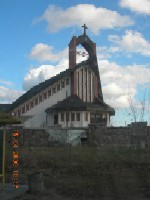
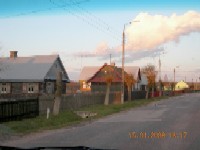
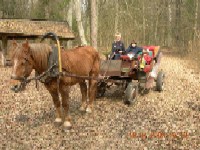

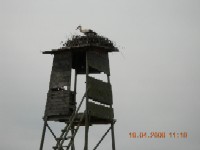

|
|
|
 |
 |
|
 |
